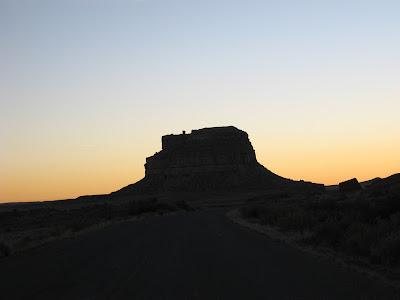Passing through Jemez and Navajo lands, the realization that I am heading to the remains of a lost civilization of high-desert landscape where long winters, short growing seasons, and marginal rainfall make it an unlikely place for a major center of ancestral Puebloan culture to take root and flourish. Yet this valley was the center of a thriving culture 1,000 years ago.
The Chacoan people's cultural flowering began in the mid 800s and persisted over 300 years. In the 1100s and 1200s change came to Chaco. New construction slowed and Chaco's role as regional center shifted. Its influence continued at Aztec, Mesa Verde, the Chuska Mountains and other centers to the north, south and west. In time the people shifted away from Chacoan ways, migrated to new areas, reorganized their world and eventually interacted with foreign cultures. The descendants are the modern Southwest Indians.
All 20 Pueblos of New Mexico and the Hopi regard Chaco and the Four Corners area as part of their ancestral homelands. Many clans trace a direct relationship to Chaco. The Pueblos of Acoma, Zia, Cochiti, Laguna, San Felipe, Santo Domingo and Zuni all have oral traditions that tell of clans migrating from Chaco and the surrounding areas. Ten Hopi clans trace their ancestry to Chaco. Chaco is honored in the prayers and songs told in many Puebloan languages, a deeply spiritual place to be honored and respected. To this day, many Navajo families live in the surrounding areas.
Arriving at Chaco, after briefly stopping at the visitor center, Glen and I began to walk about the ancient ruins. Listening within, I heard the ancestors spirits whispering to tread lightly. My body responded in deep reverence.
HOGAN
Traditional residential
structure of the Navajo people. Although Navajo people also build and,
at times, reside in sweat houses, underground homes, and summer
shelters, the hogan is the most frequently used structure. In the Navajo
religion, it is considered to be a sacred space. There are two types of hogans: the “forked stick” and the “circular” hogan.
Circular hogans like the above above are known as the “female” hogan. It differs from the forked stick variety because it does not contain a vestibule and it much larger in size. These structures are used as the primary homes for the Navajo people. Inside, cooking, domestic craft work, and friendly entertainment takes place, and there are also spaces for children to play.
Pueblo Bonito
Archeologists
call Pueblo Bonito a "Chacoan great house." This monumental public
building served surrounding communities and the region when Chaco was a
major center of Puebloan culture between A.D. 850 and 1150.
Kivas embraced many roles, including ceremony,
administration, trading, storage, hospitality communications, astronomy
and burial of the honored dead. Only a small portion seems to have
served as living quarters.
From the remnant walls and foundations,
imagine the building in use. More than 600 rooms towered four and five
stories above the valley floor, covering 3 acres. The
unique geometry enclosed to plazas with dozens of ceremonial Kivas.
Straight avenues linked the building with nearby and distant great
houses.
Kiva (THEN)
Sun is setting....casting light and shadow
time to depart...
slowly......
Thank You Chaco Canyon
For most of my adult life, my remembrance of living in times such as this has permeated the memory and senses of my current lifetime. To be amidst a place that stirs my blood and strengthens my bones is reawakening me to the Ancient Vision & Voice that I honor within Me as Wisdom.




































No comments:
Post a Comment